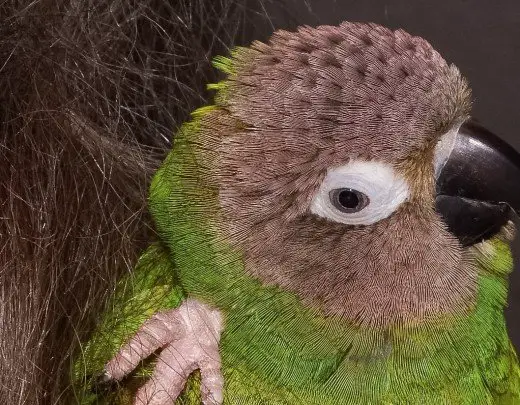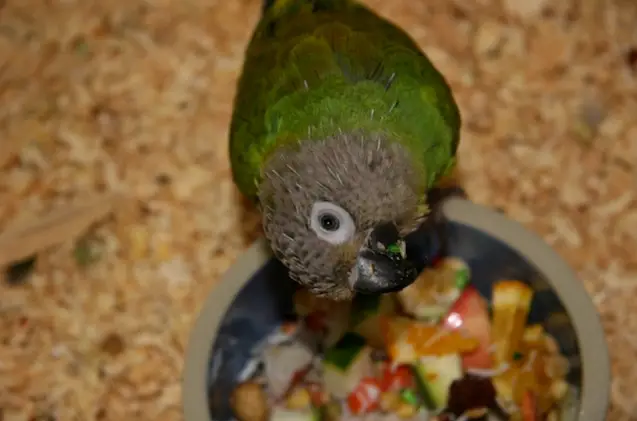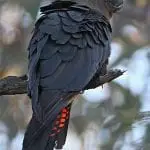Scientific Facts
| Common Name: | Dusky-headed conure |
| Scientific Name: | Aratinga weddellii |
| Life Span: | Up to 40 years (in captivity) |
| Size: | 11 inches |
| Habitat: | Coffee plantations, forest edge, forest remnants, and varzea |
| Country of Origin: | North-east Bolivia, Brazil, and West Mato Grosso, South Eastern Colombia South to East Ecuador up to Eastern Peru |
Physical Description

The dusky-headed conure is a smaller type of conure that reaches the height of 11 inches or 28 centimeters. Its tail is longer than its body, which makes the bird look good enough. It has a distinct and stocky body compared to other conures that make the bird look chubby in some cases.
While the dusky-headed conure is a small creature, this bird is quite active and energetic. Therefore, it needs a more spacious cage where it can roam with freedom. Help the bird keep its health in good condition by allowing to fly all over your house. Once you and the bird get used to it, the free flight would become a typical occurrence.
Range and Natural Habitat
This conure is common and endemic to western Amazon Basin, particularly in the South Eastern Colombia South to East Ecuador up to Eastern Peru. Also, the dusky-headed conure exists in North-east Bolivia, Brazil, and West Mato Grosso.
This type of parrot chooses to stay in semi-open habitats like forest edge, forest remnants, and varzea. But this bird also exists in the coffee plantations. This species is typically common. Unfortunately, its preferred habitat is making it highly vulnerable to other Amazonian animals.
This sociable bird is commonly seen going in small groups or pairs. In those areas that are abundant in food, this conure species flocks in a group of up to 100 birds flying together.
As it likes to stay in sparse forests, woodland edges, shrublands, and coffee plantations, this bird can be seen in tiny flocks on the freshwater bodies and clay licks where they gather with macaws, Amazon parrots, and other conures.
Compared to those Amazon parrots that are living in deeper forests, the natural habitat of a dusky-headed conure isn’t affected. Its population stays abundant and stable.
Sounds and Speech
Conures are mostly noisy and loud, but the dusky-headed conure prefers to be on the opposite. This bird is quieter compared to its close cousins. It’s one of the biggest reasons behind the popularity of this species. Since it is less likely to become loud and noisy, this species can be a great choice of pet for people who live in apartments.
Also, the dusky-headed conure can learn some basic and poorly imitated words and even familiar sounds. So, you will likely see your pets chirping and dancing to the song you are listening to.
Colors
The appearance of a dusky-headed conure reflects its calm, peaceful personality. Its body is almost pure green with a black beak and gray head. The tips of the feathers on its tail are blue. The colors black, gray, green, and blue form a perfect and subtle combination. This conure looks simple but incredibly pretty. If you are looking for a simple but good-looking bird to take care of, then the dusky-headed conure could be the best one for you.
Personality and Behavior

This shy, genteel bird can repeat words and do multiple tricks. Aside from having fun with toys, this bird also loves to dance. When taken out of the cage, the bird will sit on your shoulder and joyfully stay there without making a disturbing noise.
There are also times when this bird becomes slightly mischievous as it can mess with your things, especially your clothes and upholstery, by making holes using its beak. The dusky-headed conure enjoys chewing, climbing, swinging, and being on the play stands.
Likewise, the bird’s usual mood might change. It sometimes loses its calmness as it tends to scream and bite often when it’s about to become sexually mature. However, you need to do something about it with both love and patience.
Diet and Feeding
Instead of a pure seed-based diet, you must also feed your pet with leafy green veggies, fresh vegetables, and fruits, particularly the orange and red ones, because they are a good source of vitamin A. You can also offer cuttlebones or calcium treats.
For safety purposes, be sure to wash the foods before giving it to your pet. Don’t feed a dusky-headed conure with fried foods, avocados, chocolates, and sugary foods.
Fruits like pears, apples, oranges, bananas, cactus fruits, and pomegranates should be 30% of your pet’s overall diet. The rest should be veggies like carrots, green beans, celery, and peas on the pod, green leaves like Swiss chard, dandelion, sowthistle, chickweed, small seed mixes, spray millet. You may also include a smaller portion of oats, safflowers, buckwheat, sprouted and soaked sunflower seeds, boiled maize, cooked beans, or complete kibble.
Where to Get One?
You may look for the dusky-headed conure in the local and online pet stores serving your area. You may also get this bird from a professional breeder who specializes in breeding conures.
How to Care for a Dusky-headed Conure?
Like other conures, the dusky-headed conure will always crave for your time and attention. So, always try to spare time for your pet, teach it how to do some tricks uniquely because the equation between the owner and his or her pet stays unique. You can teach it tricks by using small bells, rings, and toys.
A dusky conure loves to socialize, so it needs your time and attention as much as possible. Your pet will be so happy to be with people, so introduce it to your family and friends. Talk to your pet and try to cuddle and stroke it on the head. The bird will love it. Also, these simple things will keep your pet in a good mood.
Hygiene is a big aspect that you should comply with. Changing the cage paper, cleaning the cage, including the toys by using dishwashing liquid mixed with water, is often required.
You can also provide your pet with a birdbath. If not, mist sprays its feathers with clean water. Do it all over the body, excluding the face twice every week. You can also do tail and wing trimming but under the supervision of a professional.
Housing
A cage that measures 30 x 36 x 30 inches with a bar spacing of at least 1/2 inch will be enough for a dusky-headed conure. However, this species tends to become an expert in escaping. For that, it is best to keep the cage secure by locking its door. Instead of wrapping the cage with clothes or towels, use a good type of cage cover. Also, keep 3 to 4 perches and multiple toys in the cage as your pet will prefer variations.
Temperature
The dusky-headed conure stays fine at a moderate room temperature that must not be more than 80 degrees Fahrenheit. Be sure to keep the bird in draft-free areas.
Common Health Issues Associated with the Dusky-Headed Conure
If your pet manifests symptoms such as loss of appetite, swollen eyes, runny nose, fluffed feathers, and frequent freezing, bring it as soon as possible to a veterinarian. Your pet is susceptible to bacterial and respiratory infections.
This bird is robust despite being small. It adapts well to various common conditions, and with proper care, it may for up to 40 years without facing a lot of troubles as time goes by. Be sure to eliminate both dampness and draft. Besides, provide more free space and sunlight. Your pet requires your help to be the best it could be.
The Dusky-Headed Conure as a Pet
The dusky-headed conure is not a famous parrot bred and raised in captivity, especially in the US. While you can buy it at some pet stores, this bird is still more common through those breeders specializing in conures.
The dusky-headed conure makes a wonderful pet because it tends to be so sweet and loving to people. It is famous for its wonderful personality when properly tamed and handled. Like other handfed parrots, spending your free time with this bird is an enjoyable and stress-relieving experience.
It tends to enjoy having its feathers lightly stoked. Your pet will likely chew on your clothes, so be extra careful if you’re wearing a branded shirt. Your pet may make tiny holes on your collar. You may even notice missing buttons. Also, your pet may mess with your earrings, necklace, and other jewelry.
Exercise
A big play stand will be great for this bird. Considering how energetic it is, your pet will happily climb on the ropes, swing, and chew toys. The play stand must be as big as your money can afford. At the same time, it should be easy to clean.
However, you should not be surprised if you have to buy a new play stand every year. As your pet loves to chew, its play stand is so prone to damage due to chewing. Toys and perches, however, will not usually uphold too much chewing.
Don’t allow your dusky-headed conure to roam around with freedom. This bird is so curious that brings it to danger in most cases. You need to supervise its free-roaming. Without proper supervision, it can end up being stepped on or be into trouble.
The cage of your pet must also incorporate the bird’s need for exercise. Due to that, the cage must be big enough to let the bird hang upside down, swing from left to right, and flap the wings without its sides touching the animal.
Noise
Conures of all types are known for their noisy shrill calls. The same is the case for a dusky-headed conure, and it will continue that trait. Expect that your pet will scream in the early morning, in the middle of the day, and before the sun goes down. In most cases, this bird does this to remind you of its presence. By using the best training techniques, you can easily control your pet’s behavior.
If the bird screams, don’t look at it, and just walk out. This will also help reduce your pet’s unwanted behavior. Bear in mind that screaming is impossible to eliminate. This bird is genetically inclined to be noisy, and it’s unnatural if your pet is not making any sound.
Tricks
The dusky-headed conure picks up tricky easily. Particularly, this bird is typically involved in the bird shows.
It is not shy and will happily work for the sake of your affection and treats. It can do anything if you teach and train the animal. The dusky-headed conure can do things like pulling a small wagon, ringing the bell, turning around, waving, and dancing.
If you want your pet to do those fun tricks, then get started by showing it how it should do the trick and motivate your pet. You will be surprised to see how fast your pet can learn.
Biting
Although this bird is unlikely to become nippy, it may bite when it develops to become sexually mature. At this period, don’t yell at your pet in case it bites you. The best thing to do is just to remain calm and don’t react to the situation.
Just go on and continue working with your pet. Make it feel like the bite is not a big deal for you. If you react negatively, your pet may learn to adopt this habit. Don’t shake your hand or look at the bird. Also, you must never try to spray or hit your pet with water. Just don’t react or say anything.
FAQs
Does the dusky-headed conure like being handled?
Conures are known to be attention seekers. Therefore, the dusky-headed conure feels great and happy whenever you play with it or brush its feathers with your hand.
Can a dusky-headed conure talk?
Like other conures, the dusky-headed conure can learn basic words. When you speak to it using those words, it knows, your pet will surely repeat them.
Does the dusky-headed conure bite?
A dusky-headed conure is calm by nature. However, it may become hostile and inclined to bite when it’s about to become sexually mature.
What can I feed my dusky-headed conure?
You can feed it with a variety of vegetables and fruits. You can also provide it with a cuttlebone or calcium treats to keep it healthy and strong.



